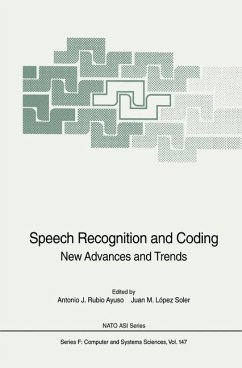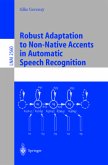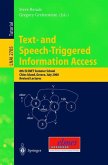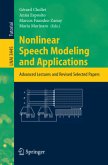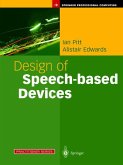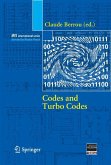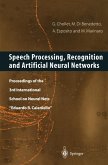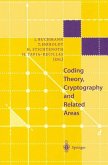Rubio AyusoNew Advances and Trends
Speech Recognition and Coding
New Advances and Trends
Herausgegeben:Rubio Ayuso, Antonio J.; Lopez Soler, Juan M.
Rubio AyusoNew Advances and Trends
Speech Recognition and Coding
New Advances and Trends
Herausgegeben:Rubio Ayuso, Antonio J.; Lopez Soler, Juan M.
- Gebundenes Buch
- Merkliste
- Auf die Merkliste
- Bewerten Bewerten
- Teilen
- Produkt teilen
- Produkterinnerung
- Produkterinnerung
Based on a NATO Advanced Study Institute held in 1993, this book addresses recent advances in automatic speech recognition and speech coding. The book contains contributions by many of the most outstanding researchers from the best laboratories worldwide in the field. The contributions have been grouped into five parts: on acoustic modeling; language modeling; speech processing, analysis and synthesis; speech coding; and vector quantization andneural nets. For each of these topics, some of the best-known researchers were invited to give a lecture. In addition to these lectures, the topics were…mehr
Andere Kunden interessierten sich auch für
![Robust Adaptation to Non-Native Accents in Automatic Speech Recognition Robust Adaptation to Non-Native Accents in Automatic Speech Recognition]() S. GoronzyRobust Adaptation to Non-Native Accents in Automatic Speech Recognition41,99 €
S. GoronzyRobust Adaptation to Non-Native Accents in Automatic Speech Recognition41,99 €![Text- and Speech-Triggered Information Access Text- and Speech-Triggered Information Access]() Steve Renals / Gregory Grefenstette (Bearb.)Text- and Speech-Triggered Information Access41,99 €
Steve Renals / Gregory Grefenstette (Bearb.)Text- and Speech-Triggered Information Access41,99 €![Nonlinear Speech Modeling and Applications Nonlinear Speech Modeling and Applications]() Gerard Chollet / Anna Esposito / Marcos Faundez-Zanuy / Maria Marinaro (eds.)Nonlinear Speech Modeling and Applications41,99 €
Gerard Chollet / Anna Esposito / Marcos Faundez-Zanuy / Maria Marinaro (eds.)Nonlinear Speech Modeling and Applications41,99 €![Design of Speech-based Devices Design of Speech-based Devices]() Ian PittDesign of Speech-based Devices40,99 €
Ian PittDesign of Speech-based Devices40,99 €![Codes and turbo codes Codes and turbo codes]() Codes and turbo codes75,99 €
Codes and turbo codes75,99 €![Speech Processing, Recognition and Artificial Neural Networks Speech Processing, Recognition and Artificial Neural Networks]() Speech Processing, Recognition and Artificial Neural Networks81,99 €
Speech Processing, Recognition and Artificial Neural Networks81,99 €![Coding Theory, Cryptography and Related Areas Coding Theory, Cryptography and Related Areas]() Johannes Buchmann / Tom Hoeholdt / Henning Stichtenoth / Horacio Tapia-Recillas (eds.)Coding Theory, Cryptography and Related Areas81,99 €
Johannes Buchmann / Tom Hoeholdt / Henning Stichtenoth / Horacio Tapia-Recillas (eds.)Coding Theory, Cryptography and Related Areas81,99 €-
-
-
Based on a NATO Advanced Study Institute held in 1993, this book addresses recent advances in automatic speech recognition and speech coding. The book contains contributions by many of the most outstanding researchers from the best laboratories worldwide in the field. The contributions have been grouped into five parts: on acoustic modeling; language modeling; speech processing, analysis and synthesis; speech coding; and vector quantization andneural nets. For each of these topics, some of the best-known researchers were invited to give a lecture. In addition to these lectures, the topics were complemented with discussions and presentations of the work of those attending. Altogether, the reader is given a wide perspective on recent advances in the field and will be able to see the trends for future work.
Hinweis: Dieser Artikel kann nur an eine deutsche Lieferadresse ausgeliefert werden.
Hinweis: Dieser Artikel kann nur an eine deutsche Lieferadresse ausgeliefert werden.
Produktdetails
- Produktdetails
- Nato ASI Subseries F: 147
- Verlag: Springer, Berlin
- Artikelnr. des Verlages: 10486127
- 1995.
- Seitenzahl: 532
- Erscheinungstermin: 20. Oktober 1995
- Englisch
- Abmessung: 235mm x 157mm x 33mm
- Gewicht: 810g
- ISBN-13: 9783540600985
- ISBN-10: 3540600981
- Artikelnr.: 09243646
- Herstellerkennzeichnung Die Herstellerinformationen sind derzeit nicht verfügbar.
- Nato ASI Subseries F: 147
- Verlag: Springer, Berlin
- Artikelnr. des Verlages: 10486127
- 1995.
- Seitenzahl: 532
- Erscheinungstermin: 20. Oktober 1995
- Englisch
- Abmessung: 235mm x 157mm x 33mm
- Gewicht: 810g
- ISBN-13: 9783540600985
- ISBN-10: 3540600981
- Artikelnr.: 09243646
- Herstellerkennzeichnung Die Herstellerinformationen sind derzeit nicht verfügbar.
I: Acoustic Modeling.- 1 Automatic Recognition of Noisy Speech.- 2 Adaptive Learning in Acoustic and Language Modeling.- 3 Evaluation of ASR Systems, Algorithms and Databases.- 4 Statistical and Discriminative Methods for Speech Recognition.- 5 Automatic Speech Labeling Using Word Pronunciation Networks and Hidden Markov Models.- 6 Heuristic Search Methods for a Segment Based Continuous Speech Recognizer.- 7 Dimension and Structure of the Vowel Space.- 8 Continuous Speech HMM Training System: Applications to Speech Recognition and Phonetic Label Alignment.- 9 HMM Based Acoustic-Phonetic Decoding with Constrained Transitions and Speaker Topology.- 10 Experiments on a Fast Mixture Density Likelihood Computation.- 11 Explicit Modelling of Duration in HMM: an Efficient Algorithm.- 12 Acoustic-Phonetic Decoding of Spanish Continuous Speech with Hidden Markov Models.- 13 HMM-Based Speech Recognition in Noisy Car Environment.- 14 Extensions to the AESA for Finding k-Nearest-Neighbours.- 15 An Efficient Pruning Algorithm for Continuous Speech Recognition.- 16 On the Performance of SCHMM for Isolated Word Recognition and Rejection.- 17 A Speaker Independent Isolated Word Recognition System for Turkish.- 18 The Speech Recognition Research System of the TU Dresden.- 19 A MMI Codebook Design for MVQHMM Speech Recognition.- 20 SLHMM: An ANN Approach for Continuous Speech Recognition.- 21 Medium Vocabulary Audiovisual Speech Recognition.- 22 SLAM: A PC-Based Multi-Level Segmentation Tool.- 23 Durational Modelling in HMM-based Speech Recognition: Towards a Justified Measure.- 24 Rejection in Speech Recognition for Telecommunication Applications.- II: Language Modeling.- 25 A Learning Approach to Natural Language Understanding.- 26 Language Models for Automatic Speech Recognition.- 27Grammatical Inference and Automatic Speech Recognition.- 28 Statistical Modeling of Segmental and Suprasegmental Information.- 29 Search Strategies For Large-Vocabulary Continuous-Speech Recognition.- 30 Two New Approaches to Language Modeling: A Tutorial.- 31 Representing Word Pronunciations as Trees.- 32 Language Models Comparison in a Robot Telecontrol Application.- 33 Keyword Propagation Viterbi Algorithm.- 34 Dialog and Language Modeling in CRIM's ATIS System.- 35 On the Use of the Leaving-One-Out Method in Statistical Language Modelling.- 36 Application of Grammar Constraints to ASR Using Signature Functions.- 37 CRIM Hidden Markov Model Based Keyword Recognition System.- 38 Modelling Phone-Context in Spanish by Using SCMGGI Models.- 39 Efficient Integration of Context-Free Language Models in Continuous Speech Recognition.- 40 Keyword Spotting, an Application for Voice Dialing.- III: Speech Processing, Analysis and Synthesis.- 41 Telecommunications Applications of Speech Processing.- 42 Disambiguating Hierarchical Segmentations of Speech Signals.- 43 Talker Tracking using two Microphone Pairs and a CrosspowerSpectrum Phase Analysis.- 44 A Text-to-Speech Services Architecture for UNIX.- 45 Comparison of Parametric Spectral Representations for Voice Recognition in Noisy Environments.- 46 Spectral Analysis of Turkish Vowels and a Comparison of Vowel Normalization Algorithms.- 47 Can You Tell Apart Spontaneous and Read Speech if You Just Look at Prosody?.- 48 The Prosodic Marking of Phrase Boundaries: Expectations and Results.- 49 Voice Source State as a Source of Information in Speech Recognition: Detection of Laryngealizations.- 50 Voice Transformations for the Evaluation of Speaker Verification Systems.- 51 Towards a More Realistic Evaluation of Synthetic Speech:A Cognitive Perspective.- 52 A Non-Linear Speech Analysis Based on Modulation Information.- 53 The Recognition Component of the SUNDIAL Project.- IV: Speech Coding.- 54 An Overview of Different Trends on CELP Coding.- 55 Concepts and Paradigms in Speech Coding.- 56 Speech Coding over Noisy Channels.- 57 Lattice and Trellis Coded Quantizations for Efficient Coding of Speech.- 58 8 kbit/sLD-CELP Coding for Mobile Radio.- 59 Subband Long-Term Prediction for LPC-Coders.- 60 On the Use of Interframe Information of Line Spectral Frequencies in Speech Coding.- 61 Speech Coding Using the Karhunen-Lóeve Representation of the Spectral Envelope of Acoustic Subwords.- 62 Excitation Construction for the Robust Low Bit Rate CELP Speech Coder.- 63 A Discrete Cosine Transform Scheme for Low-Delay Wideband Speech Coding.- 64 MOR-VQ for Speech Coding Over Noisy Analog Channels.- 65 Improved CELP Coding Using a Fully Adaptive Excitation Codebook.- V: Vector Quantization and Neural Nets.- 66 Recent Advances in JANUS: A Speech Translation System.- 67 On a Fuzzy DVQ Algorithm for Speech Recognition.- 68 On the Use of Recurrent Neural Networks for Grammar Learning and Word Spotting.- 69 LVQ-based Codebooks in Phonemic Speech Recognition.- 70 Distributed and Local Neural Classifiers for Phoneme Recognition.- 71 A VQ Algorithm Based on Genetic Algorithms and LVQ.- 72 Vector Quantization Based Classification and Maximum Likelihood Decoding for Speaker Recognition.- 73 Evidence Combination in Speech Recognition Using Neural Networks.
I: Acoustic Modeling.- 1 Automatic Recognition of Noisy Speech.- 2 Adaptive Learning in Acoustic and Language Modeling.- 3 Evaluation of ASR Systems, Algorithms and Databases.- 4 Statistical and Discriminative Methods for Speech Recognition.- 5 Automatic Speech Labeling Using Word Pronunciation Networks and Hidden Markov Models.- 6 Heuristic Search Methods for a Segment Based Continuous Speech Recognizer.- 7 Dimension and Structure of the Vowel Space.- 8 Continuous Speech HMM Training System: Applications to Speech Recognition and Phonetic Label Alignment.- 9 HMM Based Acoustic-Phonetic Decoding with Constrained Transitions and Speaker Topology.- 10 Experiments on a Fast Mixture Density Likelihood Computation.- 11 Explicit Modelling of Duration in HMM: an Efficient Algorithm.- 12 Acoustic-Phonetic Decoding of Spanish Continuous Speech with Hidden Markov Models.- 13 HMM-Based Speech Recognition in Noisy Car Environment.- 14 Extensions to the AESA for Finding k-Nearest-Neighbours.- 15 An Efficient Pruning Algorithm for Continuous Speech Recognition.- 16 On the Performance of SCHMM for Isolated Word Recognition and Rejection.- 17 A Speaker Independent Isolated Word Recognition System for Turkish.- 18 The Speech Recognition Research System of the TU Dresden.- 19 A MMI Codebook Design for MVQHMM Speech Recognition.- 20 SLHMM: An ANN Approach for Continuous Speech Recognition.- 21 Medium Vocabulary Audiovisual Speech Recognition.- 22 SLAM: A PC-Based Multi-Level Segmentation Tool.- 23 Durational Modelling in HMM-based Speech Recognition: Towards a Justified Measure.- 24 Rejection in Speech Recognition for Telecommunication Applications.- II: Language Modeling.- 25 A Learning Approach to Natural Language Understanding.- 26 Language Models for Automatic Speech Recognition.- 27Grammatical Inference and Automatic Speech Recognition.- 28 Statistical Modeling of Segmental and Suprasegmental Information.- 29 Search Strategies For Large-Vocabulary Continuous-Speech Recognition.- 30 Two New Approaches to Language Modeling: A Tutorial.- 31 Representing Word Pronunciations as Trees.- 32 Language Models Comparison in a Robot Telecontrol Application.- 33 Keyword Propagation Viterbi Algorithm.- 34 Dialog and Language Modeling in CRIM's ATIS System.- 35 On the Use of the Leaving-One-Out Method in Statistical Language Modelling.- 36 Application of Grammar Constraints to ASR Using Signature Functions.- 37 CRIM Hidden Markov Model Based Keyword Recognition System.- 38 Modelling Phone-Context in Spanish by Using SCMGGI Models.- 39 Efficient Integration of Context-Free Language Models in Continuous Speech Recognition.- 40 Keyword Spotting, an Application for Voice Dialing.- III: Speech Processing, Analysis and Synthesis.- 41 Telecommunications Applications of Speech Processing.- 42 Disambiguating Hierarchical Segmentations of Speech Signals.- 43 Talker Tracking using two Microphone Pairs and a CrosspowerSpectrum Phase Analysis.- 44 A Text-to-Speech Services Architecture for UNIX.- 45 Comparison of Parametric Spectral Representations for Voice Recognition in Noisy Environments.- 46 Spectral Analysis of Turkish Vowels and a Comparison of Vowel Normalization Algorithms.- 47 Can You Tell Apart Spontaneous and Read Speech if You Just Look at Prosody?.- 48 The Prosodic Marking of Phrase Boundaries: Expectations and Results.- 49 Voice Source State as a Source of Information in Speech Recognition: Detection of Laryngealizations.- 50 Voice Transformations for the Evaluation of Speaker Verification Systems.- 51 Towards a More Realistic Evaluation of Synthetic Speech:A Cognitive Perspective.- 52 A Non-Linear Speech Analysis Based on Modulation Information.- 53 The Recognition Component of the SUNDIAL Project.- IV: Speech Coding.- 54 An Overview of Different Trends on CELP Coding.- 55 Concepts and Paradigms in Speech Coding.- 56 Speech Coding over Noisy Channels.- 57 Lattice and Trellis Coded Quantizations for Efficient Coding of Speech.- 58 8 kbit/sLD-CELP Coding for Mobile Radio.- 59 Subband Long-Term Prediction for LPC-Coders.- 60 On the Use of Interframe Information of Line Spectral Frequencies in Speech Coding.- 61 Speech Coding Using the Karhunen-Lóeve Representation of the Spectral Envelope of Acoustic Subwords.- 62 Excitation Construction for the Robust Low Bit Rate CELP Speech Coder.- 63 A Discrete Cosine Transform Scheme for Low-Delay Wideband Speech Coding.- 64 MOR-VQ for Speech Coding Over Noisy Analog Channels.- 65 Improved CELP Coding Using a Fully Adaptive Excitation Codebook.- V: Vector Quantization and Neural Nets.- 66 Recent Advances in JANUS: A Speech Translation System.- 67 On a Fuzzy DVQ Algorithm for Speech Recognition.- 68 On the Use of Recurrent Neural Networks for Grammar Learning and Word Spotting.- 69 LVQ-based Codebooks in Phonemic Speech Recognition.- 70 Distributed and Local Neural Classifiers for Phoneme Recognition.- 71 A VQ Algorithm Based on Genetic Algorithms and LVQ.- 72 Vector Quantization Based Classification and Maximum Likelihood Decoding for Speaker Recognition.- 73 Evidence Combination in Speech Recognition Using Neural Networks.

